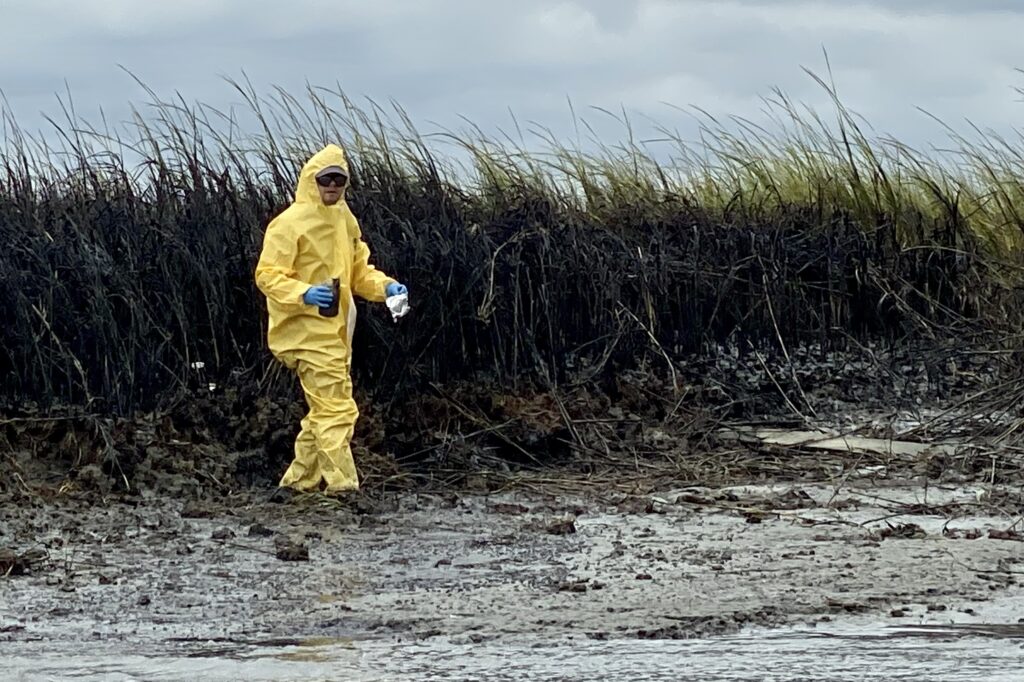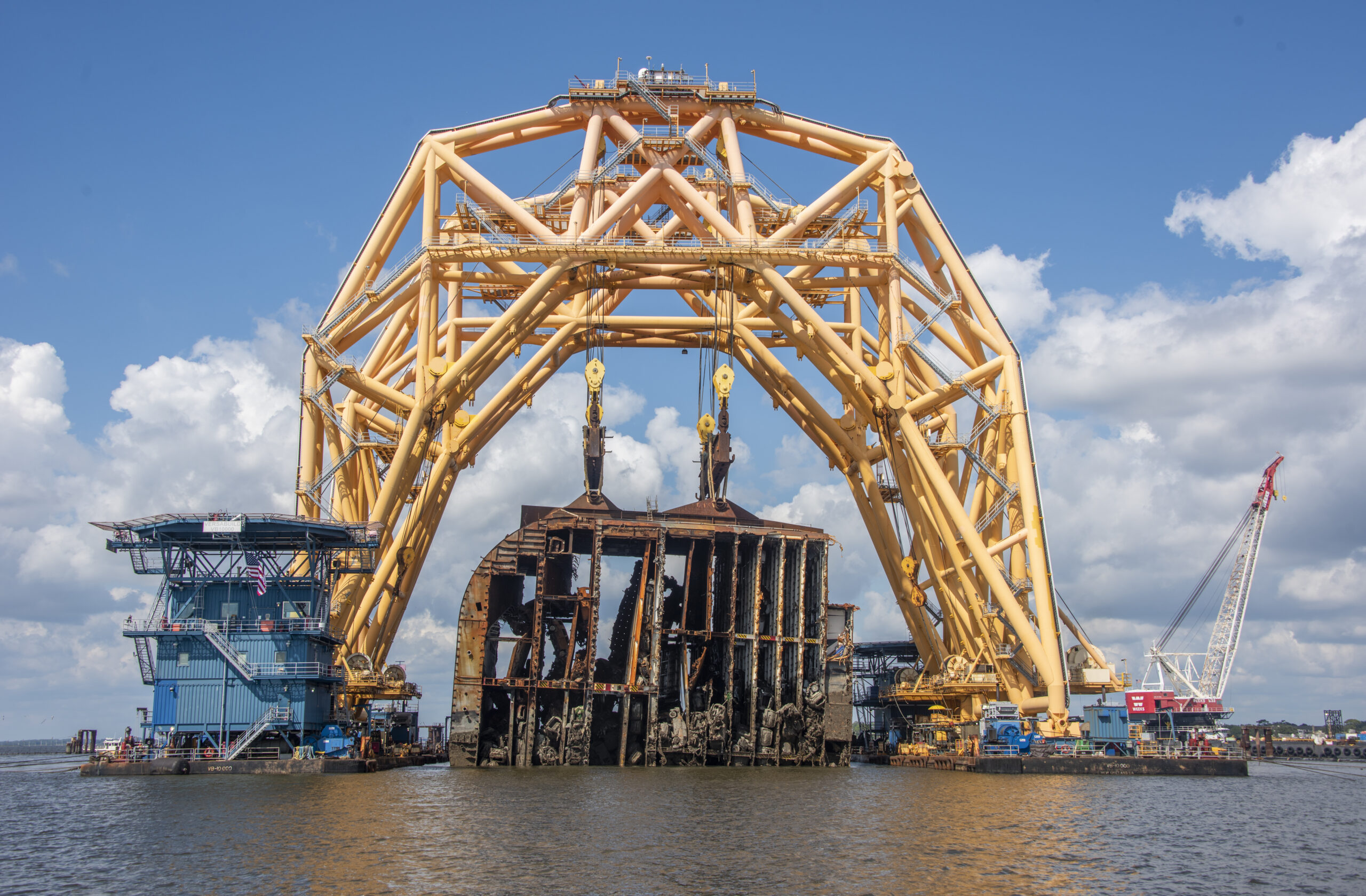This story was provided by WABE content partner Georgia Recorder.
Five months after crews removed the final section of the Golden Ray car carrier from St. Simons Sound, the owner of a fishing charter company that operates off Georgia’s coast says he is concerned about the long-term fallout following a “nightmare” two years.
Scott Owens, co-owner of The Georgia Fishing Company, said the most expensive shipwreck in U.S. history continues to impact the types of fish swimming in the channel. That has meant fewer booked trips from longtime customers and higher fuel costs to move charter boats away from the site of the September 2019 shipwreck, where oil spilled into the waterway on multiple occasions.
For more than two years, the Golden Ray sat partially submerged in the water, evolving into a monstrosity that Owens says at times resembled a loud, exhaust-blowing diesel truck as salvage crews slowly cut the massive ship into sections. Even though the final piece was removed in October, Owens says he still sees the lingering effects: It has become tough to haul in a redfish or trout in the bay around the wreckage site.
“It’s one of these things where guys who would come fish with me for the last 15, 20 years don’t want to keep fishing because the water is polluted,” he said.
“The whole thing was way worse and the state downplayed it,” Owens added. “There were people who thought it was cool to look at (the ship) but not for someone who makes their living off tourism on the water as well as for people who care about the ecosystem.”
Owens is among the people applauding a recent Glynn County Commission lawsuit seeking damages from the Golden Ray’s owner-operator and salvage company for cleanup costs, lost tourism dollars, damage to natural resources, and diminished property values resulting from the wreck and lengthy recovery.
The defendants in the lawsuit are Golden Ray owner GL NV24 Shipping, manager Hyundai Glovis, the operator and technical superintendent that managed the crew and ship, G-Marine Services, salvage contractor T&T Salvage and other parties.
Glynn County and its county seat Brunswick as well as Jekyll, Cumberland, Little Cumberland and St. Simons islands are popular tourist destinations with sun-kissed beaches and the Atlantic Ocean as the backdrop.
After the Golden Ray capsized in 2019, the removal process was hampered by an oil spill, a fire, hurricanes, a pandemic and a change in contractors. The final section of the Golden Ray was removed in October, despite initial plans to have it done by spring of 2021.
The lawsuit cites negligence as the main cause of the shipwreck, citing the findings of a Coast Guard investigation and later confirmed by the National Transportation Safety Board that while carrying more than 4,000 automobiles and over 300,000 gallons of fuel through the Port of Brunswick, unstable loading, poor calculations and other errors likely led to the ship’s tipping over.
The removal of the wreckage and environmental response plans were guided by the Unified Command, a partnership between salvage company Gallagher Marine Systems, the U.S. Coast Guard and the state Department of Natural Resources.
The now disbanded Unified Command and state officials have reported that their environmental assessments, which include water samples, have not revealed any long-term ecological impacts to the area’s marshes, beaches and water.
But the Altamaha Riverkeeper’s executive director, Fletcher Sams, says the county lawsuit supports concerns from environmentalists and many others living in the area that the damage could have long-term effects.
Sams said that without a full damage assessment, it will be difficult to determine how much wildlife has been harmed.
The lawsuit also accuses T&T Salvage of negligence while cutting up the partially submerged vessel, resulting in more oil spills and fires. As a result of switching contractors to cut up larger pieces, critics of that process say the job took much longer and was more problematic.
“Because of the way that they dismantled the ship and the way that they went about mitigating the contamination, they’ve left a big mess,” Sams said. “We’re very thankful that the county stepped in and took appropriate action to protect these resources.”
Tyler Jones, DNR spokesman for its Coastal Resources Division, said no significant abnormalities in the types of fish species have been found during ecological monitoring around the sound where the Golden Ray wrecked.
The next step, now that the salvage operation is completed, will be to finish the natural resource damage assessments. Whether future remediation is needed would be decided by the board trustees who are appointed by Gov. Brian Kemp.
A spokesman representing Hyundai Glovis said the company is aware of the lawsuit but would not comment on pending litigation.
Golden Ray is the largest cargo shipwreck in U.S. coastal waters since the 1989 Exxon Valdez disaster, which led to Congress enacting the 1990 Oil Pollution Act that expanded federal control and penalties for large oil spills.







